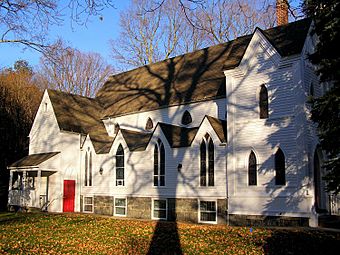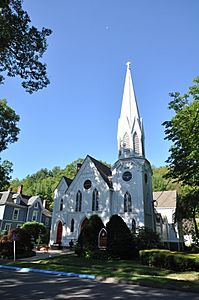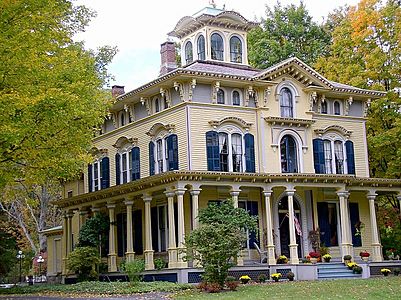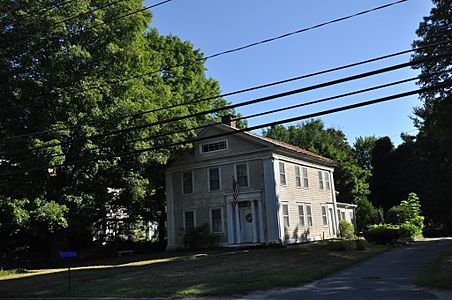Pine Meadow Historic District facts for kids
Quick facts for kids |
|
|
Pine Meadow Historic District
|
|

St. John's Church
|
|
| Location | Roughly bounded by the West Branch Farmington River, Wicket, N. Ten, Church and Main Sts., Village of Pine Meadow, New Hartford, Connecticut |
|---|---|
| Area | 68 acres (28 ha) |
| Architect | Kellogg, A.J. |
| Architectural style | Federal, Greek Revival, Queen Anne |
| NRHP reference No. | 96001463 |
| Added to NRHP | December 6, 1996 |
The Pine Meadow Historic District is a special area in New Hartford, Connecticut. It includes most of the old village of Pine Meadow, which was important in the 1800s. This village is located near a bend in the West Branch of the Farmington River. It's a great example of a small town that grew because of its factories. The district was added to the National Register of Historic Places in 1996, which means it's a historically important place.
Contents
Description and History
The town of New Hartford was first settled in the 1700s. But its main villages, like Pine Meadow, really grew in the 1800s. These villages were built near rivers because the water could power factories.
How Pine Meadow Grew
Pine Meadow started to grow when Roger Sheldon built a dam on the West Branch Farmington River in 1806. He also dug a special channel called a power canal. This canal helped carry water from the river to different factories. The canal was located between what are now Wickett Street and Main Street.
Main Street is now U.S. Route 44, but back then it was called the Albany Turnpike. Wickett Street is named after the special gates, or "wickets," that controlled the water flow to the factories.
Village Industries
Many different factories used the river's power. There was a place that made things from brass, a textile mill that made cloth, and a woodworking factory. The woodworking factory, owned by the Chapin family, became one of the biggest businesses in the village.
Today, most of these old factories are gone. But you can still see many of the homes where the workers lived. There are also bigger, fancier houses that belonged to the factory owners and managers.
Buildings and Homes
The Pine Meadow Historic District is bordered by the West Branch Farmington River to the north and east. On the southwest, there's a hill that runs along Main Street.
Because the village was busiest in the mid-1800s, many of the important buildings have a style called Greek Revival or Italianate. One of the most famous houses is the Philip Chapin House. It's a beautiful example of Italianate style and belonged to one of the factory owners.
There are also many homes that were built for the workers. These range from small houses for one family to larger buildings called tenements, where many families lived.
A central part of the village is a triangular green space. It's formed by Main Street and Church Street. Here, you can see the Chapin House and St. John's Episcopal Church. St. John's Church is a lovely example of Gothic Revival architecture.
Gallery







